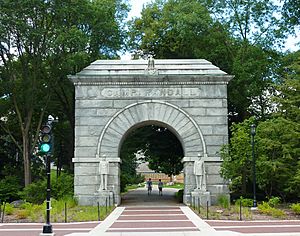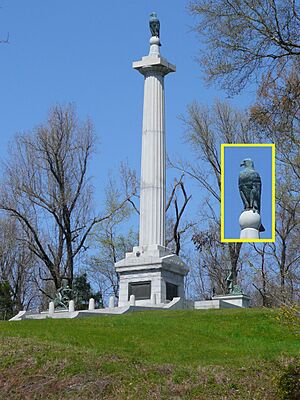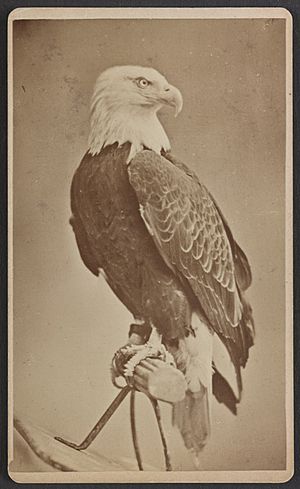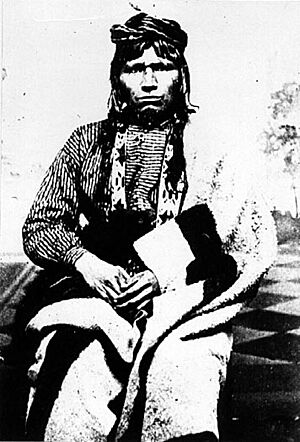Old Abe facts for kids
Old Abe (born May 27, 1861 – died March 26, 1881) was a famous bald eagle. He became the special animal friend, or mascot, of the 8th Wisconsin Volunteer Infantry Regiment during the American Civil War. After the war, his image became very well-known. You can see an eagle like him on the logo for Case Corporation farm equipment. He also inspired the screaming eagle on the patch of the U.S. Army's 101st Airborne Division.
Contents
Old Abe's Early Life and Capture
Old Abe was captured as a young eaglet by a Native American man named Ahgamahwegezhig, also known as "Chief Sky." Chief Sky was the son of an important leader of the Lac du Flambeau Ojibwe tribe.
In the spring of 1861, Chief Sky was hunting and fishing near the Flambeau River in what is now the Chequamegon National Forest in Wisconsin. He spotted a nest high in a tree with two baby eagles. To get them, he cut down the tree. Sadly, one eaglet died from the fall, but the other survived and became Chief Sky's pet.
Later that summer, Chief Sky and his father traveled down the Chippewa River to trade goods. At Jim Falls, Wisconsin, they met Daniel McCann. The Native Americans sold the young eagle to McCann for a bushel of corn.
In August 1861, a group of soldiers called the "Eau Claire Badgers" was forming in Wisconsin. Daniel McCann offered to sell the eagle to them for $2.50. One soldier, Frank McGuire, started collecting 25 cents from each person. A civilian named S. M. Jeffers refused to help at first, which made the soldiers upset. But then Jeffers laughed, paid for the eagle himself, and gave it to the company. The soldiers cheered!
The soldiers named the eagle "Old Abe" after President Abraham Lincoln. A special perch was built for him to ride into battle, and a young soldier named James McGinnis volunteered to take care of him.
Old Abe in the Civil War

On September 3, 1861, the "Eau Claire Badgers" traveled to Madison, Wisconsin. They officially joined the army as Company C of the 8th Wisconsin Volunteer Infantry Regiment. Because of Old Abe, they became known as the "Eagle Company," and their whole regiment was called the "Eagle Regiment." After some training, they began their important role in the American Civil War.
Early Battles and Adventures
On October 12, the regiment left for St. Louis, Missouri. Old Abe actually got loose there and flew away, but a policeman quickly found him and brought him back! The next day, the regiment moved to Fredericktown, Missouri, and fought in the Battle of Fredericktown on October 20, 1861.
Later, they joined General John Pope's army and took part in the Battle of Island Number Ten in March and April 1862. This was a big victory for the Union, opening up the Mississippi River.
Fighting Near Corinth
In May 1862, the 8th Wisconsin helped in the Siege of Corinth, which was a battle to control important railroad lines in Mississippi. On May 9, 1862, during the Battle of Farmington, Old Abe experienced his first serious fighting. He spread his wings and screamed! Sadly, Captain Perkins died in this battle.
After a skirmish, the Confederate soldiers left Corinth, and the Union army marched into the city. James McGinnis, Old Abe's first caretaker, became very sick and had to leave. Thomas J. Hill took over caring for the eagle, followed by David McLain.
On October 3 and 4, the Confederate armies attacked Corinth again in the Second Battle of Corinth. It was a very tough fight, and many soldiers from the 8th Wisconsin were killed or wounded. Newspapers at the time claimed Old Abe flew over the battle lines. However, David McLain, who was there, said this wasn't true. He explained that a bullet cut the rope holding Old Abe to his perch, and the eagle flew about 50 feet down the line. Old Abe would get excited in battle, spread his wings, and scream, but he never flew over enemy lines.
The Vicksburg Campaign

In November 1862, the regiment moved to Grand Junction, Tennessee, to join General Ulysses S. Grant's first attempt to capture Vicksburg, Mississippi. Vicksburg was a very important city on the Mississippi River.
During this campaign, Old Abe and the 8th Wisconsin were in the middle of the action. In Oxford, Mississippi, a Southern girl called Old Abe a "Yankee Buzzard," which made the soldiers angry! Confederate soldiers often tried to kill or capture Old Abe, but they never succeeded.
On December 20, the Wisconsin regiment was captured by Confederate cavalry at Holly Springs, Mississippi. They were later released. In March 1863, the regiment moved to Helena, Arkansas, to join Grant's new plan to cross the Mississippi River and capture Vicksburg.
They joined General William Tecumseh Sherman's army and fought in several battles, including the capture of Jackson, Mississippi. On May 22, the regiment took part in a big attack on Vicksburg. When this attack failed, Grant began a siege of the city.
During the siege, the 8th Wisconsin left Vicksburg for other missions, including driving Confederate forces out of Richmond, Louisiana. They returned to Vicksburg shortly after it surrendered on July 4, 1863. After the siege, John Burkhardt became Old Abe's caretaker.
General William T. Sherman thought highly of the 8th Wisconsin. He wrote a letter praising the regiment for always doing their duty, showing courage in battles like Jackson and Vicksburg, and patiently enduring sickness. He hoped their ranks would be refilled so they could continue to fight for the Union.
Other famous generals like Grant, Sherman, and Logan would often salute Old Abe as they passed the regiment. This always made the soldiers cheer, and Old Abe would spread his wings!
Red River Campaign
In early 1864, many soldiers from the 8th Wisconsin were due for a break. However, General Sherman asked them to join the Red River Campaign in Louisiana. This campaign aimed to capture Shreveport.
On March 10, 1864, the regiment traveled by boat down the Mississippi River and up the Red River. They helped capture Fort De Russy, which opened the river to Alexandria.
The soldiers then waited for other Union forces. During this time, General Joseph A. Mower led a surprise attack on Confederate defenses at Henderson's Hill, capturing many prisoners and guns without firing a shot!
The Union forces continued upriver, but on April 8, they were defeated at the Battle of Mansfield. This forced a retreat. The 8th Wisconsin fought in battles like Battle of Pleasant Hill and helped protect the retreating army.
After returning to Alexandria, the troops helped build Bailey's Dam to get Union ships over rapids. They then continued their retreat, fighting more battles like Battle of Mansura and Battle of Yellow Bayou. By May 24, they were back in Vicksburg.
In June 1864, the 8th Wisconsin fought in their last battle at Ditch Bayou in Arkansas. They lost some soldiers but helped keep the Mississippi River safe.
Old Abe's Return to Wisconsin
On June 19, 1864, 240 veteran soldiers from the 8th Wisconsin, along with Old Abe, left for a break back home. They arrived in Chicago on June 21 and in Madison, Wisconsin, on June 22. Flags were displayed, bells rang, and crowds cheered for the veterans and Old Abe at the Capitol.
A few days later, on June 26, 56 veterans from Company C arrived in Eau Claire with the eagle. They were met with cannons, music, songs, and a big feast. In Chippewa Falls, a huge wigwam was built, and a feast was held for Old Abe and the soldiers on July 4, 1864. Afterward, a parade with a band, the eagle, and the veterans marched through the streets.
In August 1864, Old Abe and the veterans returned to Memphis. The 8th Wisconsin continued to fight, including a battle at Hurricane Creek, Mississippi, on August 13, 1864. This was Old Abe's very last battle.
On September 16, 1864, the original three-year enlistment for the 8th Wisconsin soldiers ended. The veterans headed north with Old Abe, as the regiment had decided to give the eagle to the state of Wisconsin. On September 21, they reached Chicago. John Burkhardt, the eagle's caretaker, passed Old Abe to John H. Hill, who had been wounded earlier in the war. On September 22, Hill carried Old Abe into Madison at the head of 70 veterans. On September 26, Captain Victor Wolf officially presented Old Abe to Governor James T. Lewis, who then gave the eagle to the state's Quartermaster General.
Old Abe After the War
After the war, Old Abe became a "War Relic" for Wisconsin. The state created an "Eagle Department" in the Capitol building, which included a special two-room "apartment" for him, a custom bathtub, and a caretaker. John Hill later served as his caretaker.
Old Abe became a national celebrity! People and groups from all over the country wanted him to appear at their events. Old Abe was at the 1876 Centennial Exposition in Philadelphia, Pennsylvania, and the 1880 Grand Army of the Republic National Convention. He also helped raise money for charities like the Sanitary Fair and the Soldiers' Orphan's Home.
In February 1881, a small fire started in the Capitol basement. Old Abe actually helped by making a loud noise, which alerted people to the fire. It was put out quickly, but Old Abe breathed in a lot of thick, black smoke. About a month later, he became weak and sick. On March 26, 1881, Old Abe died in the arms of his caretaker, George Gilles, despite doctors' efforts.
On September 17, 1881, Old Abe's stuffed body was placed in a glass case in the Capitol building. He was moved around the Capitol a few times. In 1903, President Theodore Roosevelt saw Old Abe's remains and was happy to see the eagle he had learned about as a child. However, in 1904, Old Abe's remains and the glass case were destroyed in a terrible fire that burned down the Capitol building.
Since 1915, a replica of Old Abe has been in the Wisconsin State Assembly Chamber in the Capitol. Another replica is on display at the Wisconsin Veterans Museum in Madison. You can also see a stone sculpture of Old Abe at the top of the Camp Randall Arch.
Old Abe's Legacy
Old Abe's image has lived on in several ways:
- In 1865, Jerome Case used Old Abe as the trademark for his J. I. Case farm equipment company in Wisconsin. This trademark was used until 1969.
- The patch for the U.S. Army's 101st Airborne Division shows a picture of Old Abe. This design comes from Wisconsin's Civil War traditions.
- Old Abe is the mascot for Eau Claire Memorial High School, whose sports teams are called the "Old Abes." He is also the mascot for Racine Case High School, whose teams are the "Eagles."

101st Airborne Division shoulder patch
|






